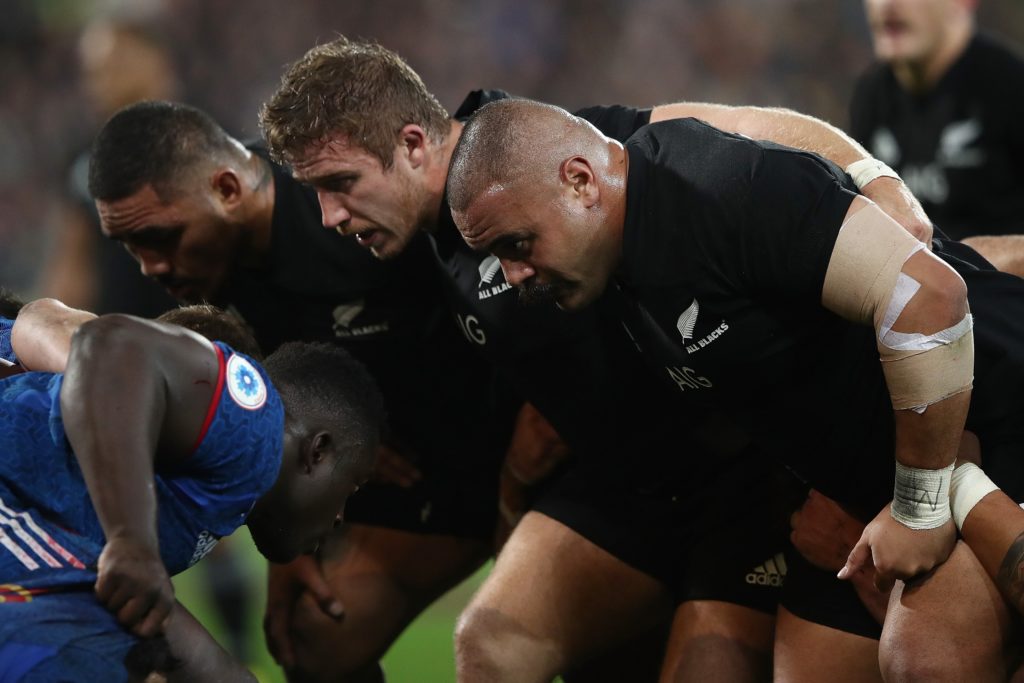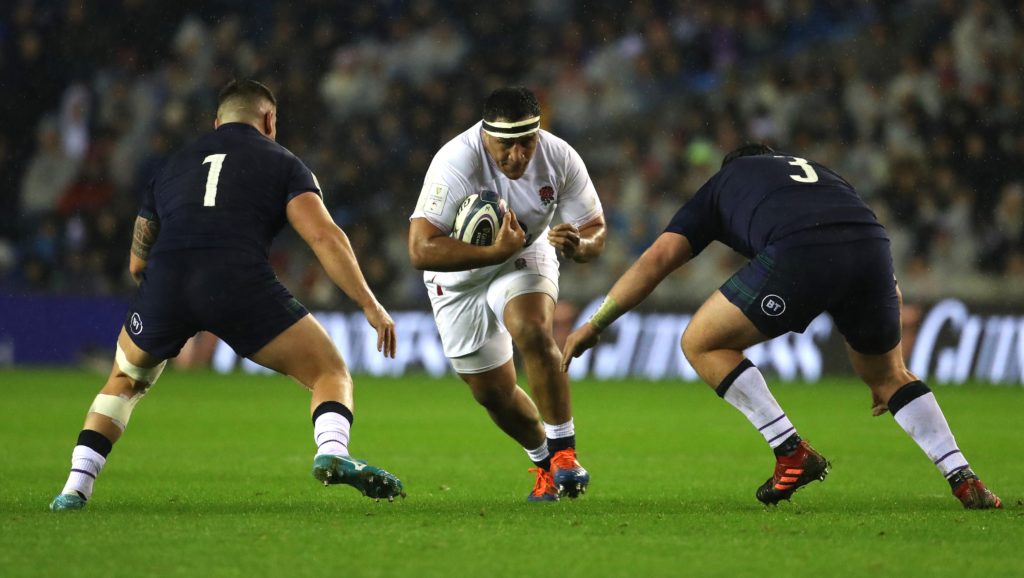When New Zealand Rugby chairman Brent Impey announced the All Blacks squad to travel to Japan for last year’s Rugby World Cup, there was one glaring omission.
Owen Franks, a student of 108 test caps, was nowhere to be found – despite being New Zealand’s first-choice tighthead from 2010 right up until the squad announcement.
In hindsight, Franks’ absence wasn’t as big a surprise as it was painted to be when the team was named. After all, head coach Steve Hansen had made it very clear to his players throughout the Super Rugby season that the selectors were interested in mobile, ball-running props as much as they were in big burly men who could scrum.
“I understand there was a message from the end-of-year tour from the All Blacks around the quality of the props in the Northern Hemisphere and work rate they’re getting through compared to what we offer,” Blues forwards coach Tom Coventry told Stuff at the halfway stage of Super Rugby in 2019.
“It’s probably a fair criticism. I think their game has probably grown. They’ve watched the Southern Hemisphere teams play and the difference often is the ability of the forwards, particularly the tight forwards. So there has been an emphasis on them doing more, scrummaging, getting up off the ground and carrying a couple of times, cleaning out well, and just being consistent with other aspects of the game.”
Franks, for all he offered at the set-piece, would never have described himself as a ball-player. He wasn’t the only capped prop to miss out on selection, either. Karl Tu’inukuafe, whose rise to fame in 2018 is well documented, quickly found himself down the pecking order.

“In today’s game you need props that can do more than just scrum and lift in the lineout so that’s been our challenge in the last 12 months that we’ve put to our front rowers and some of them are progressing really well with it and others are struggling,” Hansen said following the squad naming.
“It’s not that [Tu’inukuafe’s] done anything wrong, it’s just that we’ve said that we want mobile, ball-playing props who can also do their roles.”
The likes of Atu Moli and Angus Ta’avao, meanwhile, profited from the selectors’ change in tack.
One year on from the World Cup final – a match the All Blacks were absent from – and it’s hard to know what new head coach Ian Foster’s approach is to the propping situation.
Franks is overseas while Moli and Ta’avao spent the majority of the Super Rugby season on the sidelines due to injury.
In today’s game you need props that can do more than just scrum and lift in the lineout so that’s been our challenge in the last 12 months that we’ve put to our front rowers and some of them are progressing really well with it and others are struggling.
Steve Hansen following the All Blacks 2019 RWC squad announcement
Ta’avao has played just a handful of games for Auckland and Moli is gone for the year, which has forced considerable changes in the All Blacks squad.
Loosehead Alex Hodgman was one of the biggest surprise packages of the Blues’ Super Rugby Aotearoa campaign, while Tyrel Lomax is slowly building his resume and both earned spots in the team. Tu’inukuafe was also recalled.
Ofa Tuungafasi, who has never struggled in the loose but hasn’t always been as confident at scrummaging, came of age for the Blues and has started in all four Bledisloe Cup tests at tighthead. He’s partnered Tu’inukuafe and, when fit, elder statesman Joe Moody. Nepo Lauala has also featured, though not as much as he would have liked.
Aside from Tu’inukuafe – who’s admitted that scrummaging will always be his forte, despite the selectors’ demands for greater mobility – the other five props have running games that would have been unheard of for a prop during the last century.
Compared to other props in the modern game, however, it would take a brave person to suggest that the New Zealand contingent would rival their opposition around the world.
That should have been abundantly clear to anyone who witnessed the Wallabies’ well-taken win in Brisbane over the weekend, when bruising behemoth Taniela Tupou entered the fray early in the second half.

It’s not often that a prop accrues the most metres gained of any of the 16 substitutes used in a test match, but that’s exactly what happened last weekend.
First and foremost, however, Tupou set to work dismantling the All Blacks at scrum time, a set piece contested by seven each side following red cards to Ofa Tuungafasi and Lachlan Swinton.
Tupou, a Tongan-born, New Zealand-educated tighthead, instantly added impetus to the Wallabies’ shove – almost turning the All Blacks’ ball over on their own five-metre line, then helping his pack earn a penalty just moments later. Reece Hodge converted the shot at goal to bring the Wallabies within a point of their opposition.
With that out of the way, the Tongan Thor then set his sights on getting involved in the more glamourous aspects of the game, and it was in the final 10 minutes of the match that we really saw what Tupou is capable of.
The Reds tighthead has so often bulldozed his way through players at the Super Rugby level but he’s never great brought that same impact against top tier opposition on the international stage. That changed on Saturday night as the game entered its final stages.
With that out of the way, the Tongan Thor then set his sights on getting involved in the more glamourous aspects of the game, and it was in the final 10 minutes of the match that we really saw what Tupou is capable of.
In the 74th minute, with Australia camped just outside the New Zealand 22, Tupou picked up the ball and decided to bust through himself. He blasted through Rieko Ioane and Sam Whitelock, chewing through almost 10 metres.
Not content with that, Tupou readied himself for the next hit-up and before another forward could put his hand up to make a carry, the 135kg prop again took on the New Zealand defence. Ioane was again overrun while Ardie Savea and Damian McKenzie combined to eventually wrestle Tupou to the ground.
He still wasn’t done. A handful of phases later, with the breakdown set just metres from the All Blacks’ tryline, Tupou loomed large. A short pass from Folau Fainga’a gave Tupou the ball with just TJ Perenara and Anton Lienert-Brown ahead of him, and the two backs were never going to prevent the prop from smashing over the line.
With Hodge’s conversion, the Wallabies took an unassailable 24-15 lead.
It was a cameo made in heaven, and one that really emphasised what the All Blacks are missing from their pack right now – big, mobile ball carriers.
Ardie Savea is exemplary at producing go forward for the men in black but he cedes 40kg to Tupou. Sam Cane has added a new string to his bow this year in terms of his attacking game, but he suffers from the same problem as Savea.
Even Brodie Retallick, who’s on sabbatical this year, can’t generate the same momentum as the likes of Tupou and England’s Mako Vunipola – whose low centres of gravity make them incredibly tough to bring to the floor.

The simple fact is that a dynamic prop is a weapon that’s becoming a necessity in the international game, a weapon that New Zealand is missing.
When Super Rugby was suspended earlier in the year, Tupou was sitting on 194 metres carried – 70m more than the next best tighthead prop, fellow Wallaby Allan Alaalatoa. Meanwhile, South Africa’s Steven Kitshoff was the best carrying loosehead.
In fact, you have to look eight names down the list before you find the first Kiwi – somewhat surprisingly, Karl Tu’inukuafe – the only New Zealand-eligible prop in the top 10.
It appears that despite the messages delivered to the Super Rugby set-ups last year, the New Zealand props are still behind the curve when it comes to delivering power on attack, and that could come back to bite the All Blacks again if something doesn’t change.
While Steve Hansen tried to re-invent the All Blacks’ props at the eleventh-hour last year, they still fell well-short of England’s tight five in their World Cup semifinal loss. If Ian Foster can change the focus from year one, however, then when France 2023 rolls around, New Zealand may actually have an arsenal capable of competing with the best in the world.
Of course, Australia’s Taniela Tupou will remain a few steps ahead of the curve and will cause many a headache for opposition teams. Good luck to the poor blokes tasked with bringing him to ground.



Comments
Join free and tell us what you really think!
Sign up for free